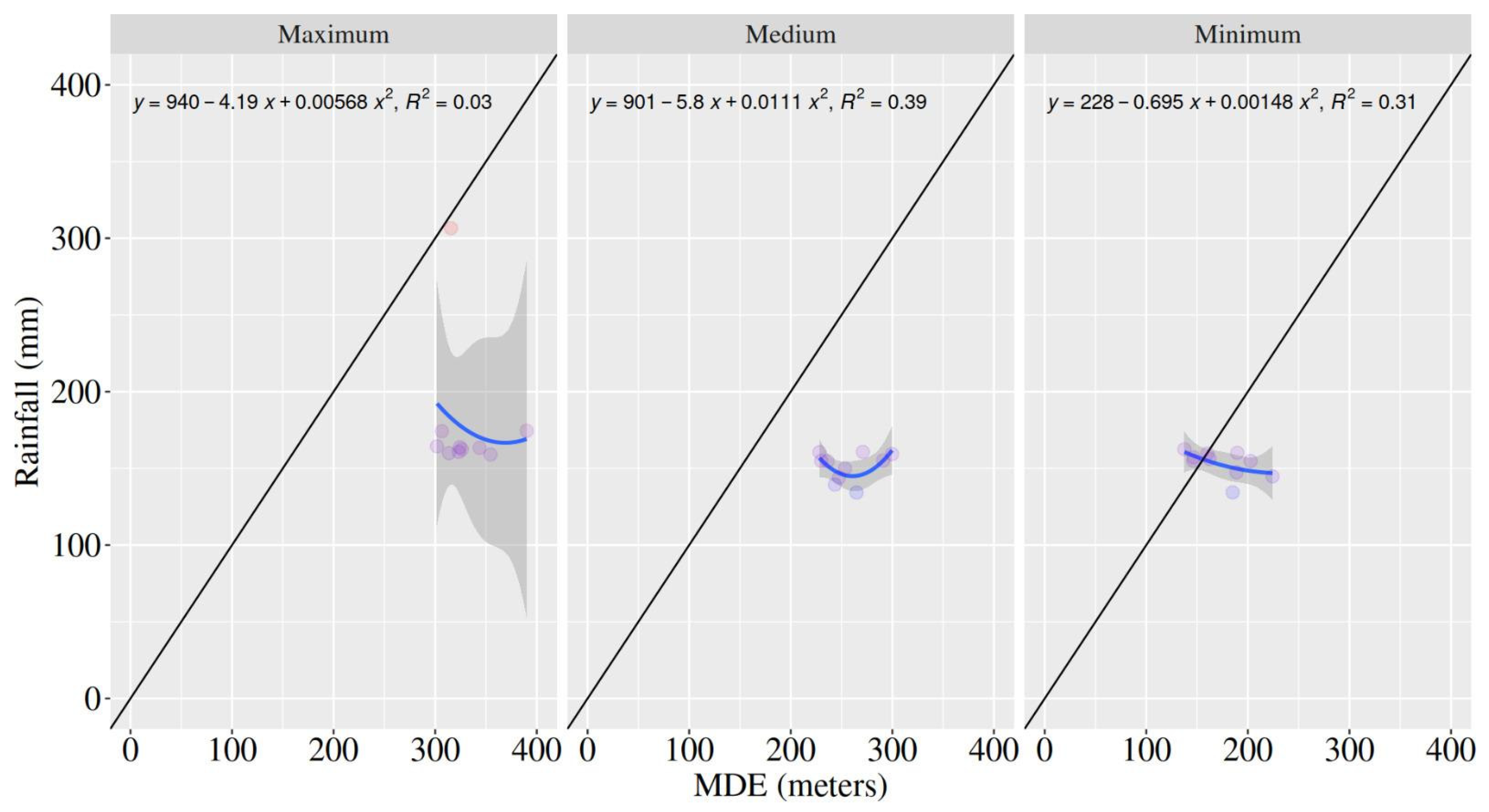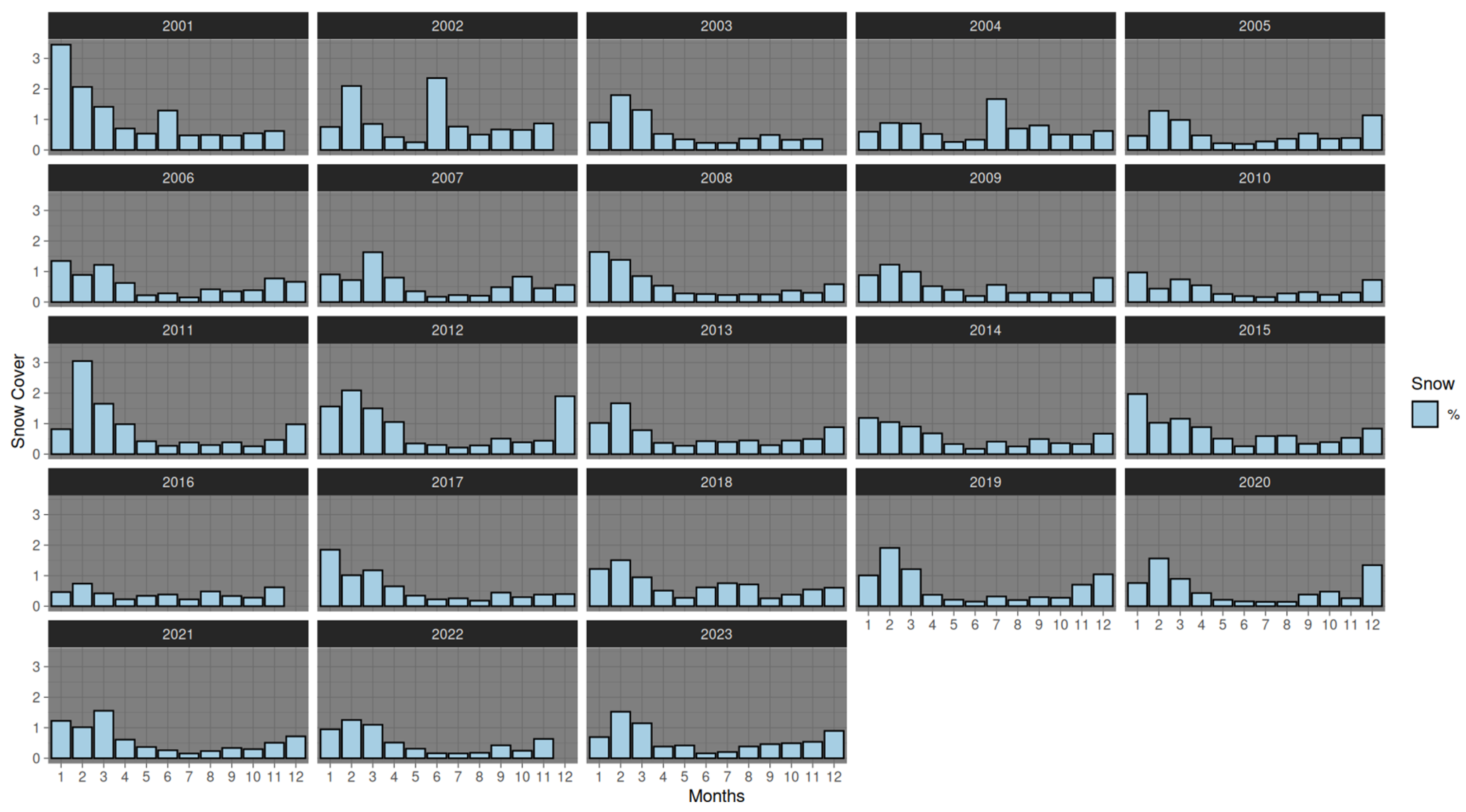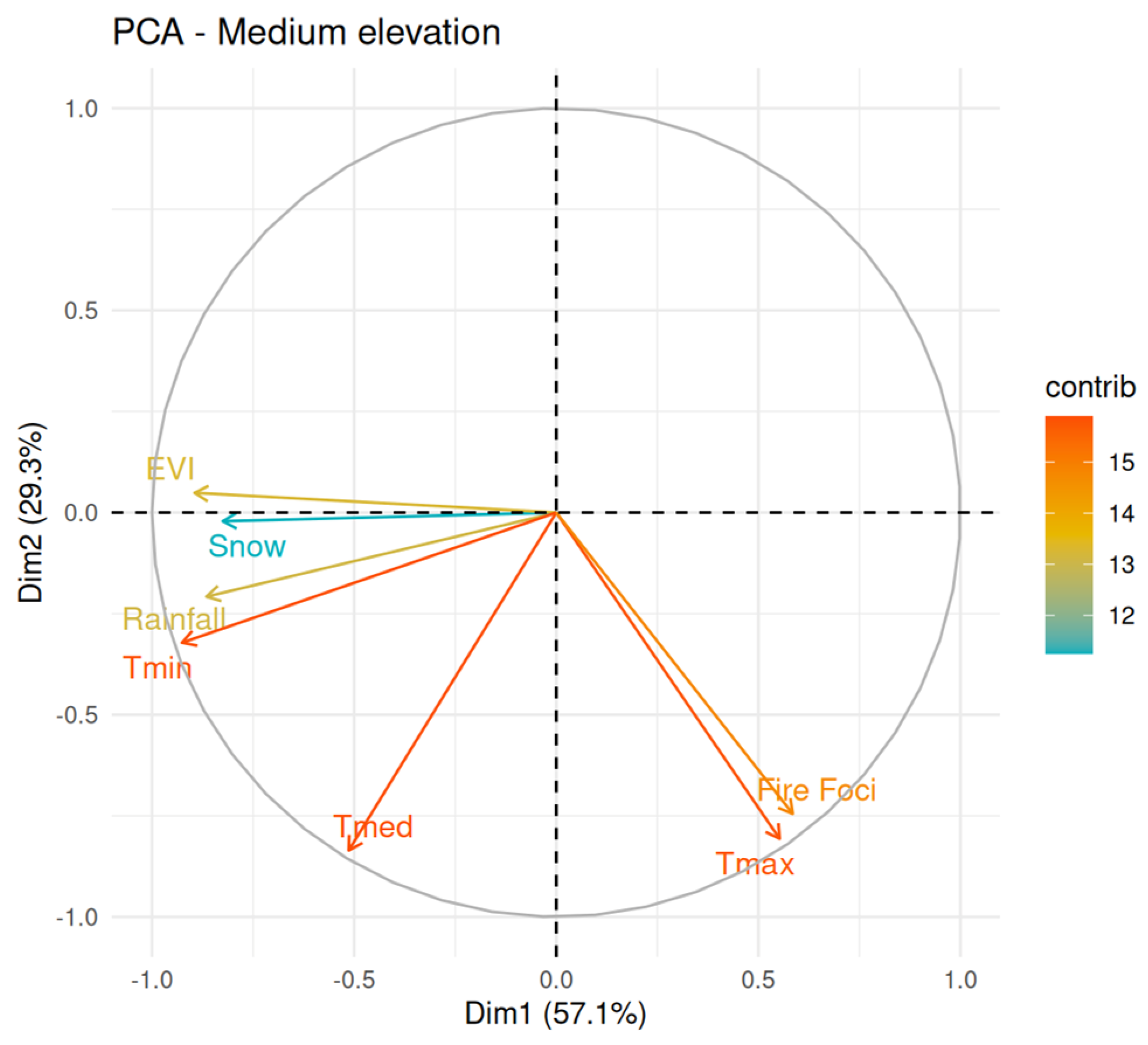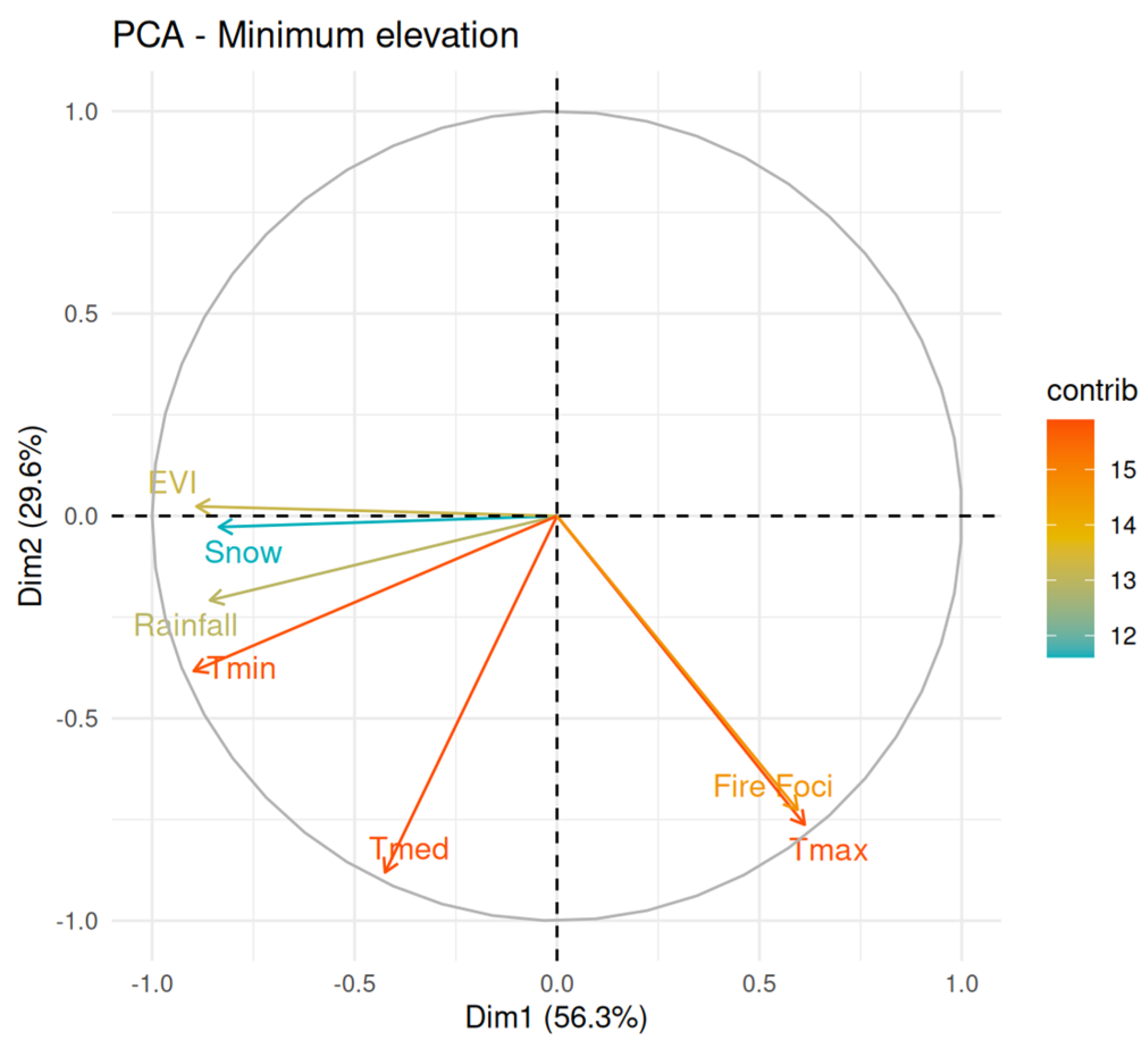Precipitation Trends and Andean Snow Cover: Climate Interactions and Hydrological Impacts in the Acre River Basin (1982–2023)
Abstract
:1. Introduction
2. Materials and Methods
2.1. Study Area
2.2. Rainfall Data and Digital Elevation Model
2.3. Air Temperature and Fire Foci Data
2.4. Enhanced Vegetation Index
2.5. Snow Cover Data
2.6. Statistical Analysis
2.7. Spatial Resolution of Data
3. Results
3.1. Rain in the Acre River Basin
3.2. Air Temperature, Fire, and Enhanced Vegetation Index in the Acre River Basin
3.3. Snow Cover
3.4. PCA in the Acre River Basin
4. Discussion
4.1. Rainfall Behavior in the Acre River Basin
4.2. Air Temperature, Fire, and Vegetation Trends in the Acre River Basin
4.3. Reduction of Andean Snow and Impact on the Acre River Basin
5. Conclusions
Author Contributions
Funding
Institutional Review Board Statement
Informed Consent Statement
Data Availability Statement
Acknowledgments
Conflicts of Interest
References
- IPCC. Climate Change 2022: Impacts, Adaptation and Vulnerability. Contribution of Working Group II to the Sixth Assessment Report of the Intergovernmental Panel on Climate Change. 2022. Available online: https://www.ipcc.ch/report/ar6/wg2/downloads/report/IPCC_AR6_WGII_SummaryVolume.pdf (accessed on 20 April 2024).
- Marengo, J.A.; Espinoza, J.C. Extreme seasonal droughts and floods in Amazonia: Causes, trends and impacts. Int. J. Climatol. 2016, 36, 1033–1050. [Google Scholar] [CrossRef]
- da Silva, S.S.; Brown, F.; de Oliveira Sampaio, A.; Silva, A.L.C.; dos Santos, N.C.R.S.; Lima, A.C.; de Souza Aquino, A.M.; da Costa Silva, P.H.; do Vale Moreira, J.G.; Oliveira, I.; et al. Amazon climate extremes: Increasing droughts and floods in Brazil’s state of Acre. Perspect. Ecol. Conserv. 2023, 21, 311–317. [Google Scholar] [CrossRef]
- Dolman, D.I.; Brown, I.F.; Anderson, L.O.; Warner, J.F.; Marchezini, V.; Santos, G.L.P. Re-thinking socio-economic impact assessments of disasters: The 2015 flood in Rio Branco, Brazilian Amazon. Int. J. Disaster Risk Manag. 2018, 31, 212–219. [Google Scholar] [CrossRef]
- Oliveira, A.V.d.; Serrano, R.O.P.; Mesquita, A.A.; Moreira, J.G.d.V. Temporal trend and estimation of the hydrological risk of maximum rainfall and flow extremes in the City of Rio Branco, Acre, Brazil. Rev. Bras. Meteorol. 2022, 36, 749–758. [Google Scholar] [CrossRef]
- Sorribas, M.V.; Paiva, R.C.D.; Melack, J.M.; Bravo, J.M.; Jones, C.; Carvalho, L.; Beighley, E.; Forsberg, B. Projections of climate change effects on discharge and inundation in the Amazon basin. Clim. Change 2016, 136, 555–570. [Google Scholar] [CrossRef]
- Silva, J.R.D.S.; Taveira, M.K.; Mesquita, A.A.; Serrano, R.O.P.; Moreira, J.G.d.V. Caracterização temporal da precipitação pluviométrica na cidade de Cruzeiro do Sul, Acre, Brasil. Uáquiri 2021, 3, 64–75. [Google Scholar] [CrossRef]
- Moreto, V.B.; Aparecido, L.E.O.; Rolim, G.S.; Moraes, J.R.S.C. Agrometeorological models for estimating sweet cassava yield. Pesqui. Agropecu. Trop. 2018, 48, 43–51. [Google Scholar] [CrossRef]
- Funk, C.; Peterson, P.; Landsfeld, M.; Pedreros, D.; Verdin, J.; Shukla, S.; Husak, G.; Rowland, J.; Harrison, L.; Hoell, A.; et al. The climate hazards infrared precipitation with stations—A new environmental record for monitoring extremes. Sci. Data 2015, 2, 150066. [Google Scholar] [CrossRef]
- Alejo, L.A.; Alejandro, A.S. Validating CHIRPS ability to estimate rainfall amount and detect rainfall occurrences in the Philippines. Their. Appl. Climatol. 2021, 145, 967–977. [Google Scholar] [CrossRef]
- Aksu, H.; Akgul, M.A. Performance evaluation of CHIRPS satellite precipitation estimates over Turkey. Theor. Appl. Climatol. 2020, 142, 71–84. [Google Scholar] [CrossRef]
- Rivera, J.A.; Marianetti, G.; Hinrichs, S. Validation of CHIRPS precipitation dataset along the Central Andes of Argentina. Atmos. Res. 2018, 213, 437–449. [Google Scholar] [CrossRef]
- López-Bermeo, C.; Montoya, R.D.; Caro-Lopera, F.J.; Díaz-García, J.A. Validation of the accuracy of the CHIRPS precipitation dataset at representing climate variability in a tropical mountainous region of South America. Phys. Chem. Earth (Pt A B C) 2022, 127, 103184. [Google Scholar] [CrossRef]
- Brasil, J.B.; Palácio, H.A.D.Q.; Neto, J.R.D.A.; Filho, J.C.R.; de Andrade, E.M. Características das chuvas e interceptação vegetal no Bioma Caatinga. Irriga 2017, 22, 560–574. [Google Scholar] [CrossRef]
- Farias, C.F.d.S.; José, J.V.; Leite, K.N.; Souza, M.D.; Amaral, M.A.C.M.; Silva, S.S.d. Rainfall interception mapping in the Alto Juruá hydrographic basin, Acre. Res. Soc. Dev. 2022, 11, e6711124343. [Google Scholar] [CrossRef]
- Peng, X.; Zhang, T.; Frauenfeld, O.W.; Du, R.; Jin, H.; Mu, C. A holistic assessment of 1979–2016 global cryospheric extent. Earth’s Future 2021, 9, e2020EF001969. [Google Scholar] [CrossRef]
- Braun, M.H.; Malz, P.; Sommer, C.; Farías-Barahona, D.; Sauter, T.; Casassa, G.; Soruco, A.; Skvarca, P.; Seehaus, T.C. Constraining glacier elevation and mass changes in South America. Nat. Clim. Change 2019, 9, 130–136. [Google Scholar] [CrossRef]
- Saavedra, F.A.; Kampf, S.K.; Fassnacht, S.R.; Sibold, J.S. Changes in Andes snow cover from MODIS data, 2000–2016. Cryosphere 2018, 12, 1027–1046. [Google Scholar] [CrossRef]
- Malmros, J.K.; Mernild, S.H.; Wilson, R.; Tagesson, T.; Fensholt, R. Snow cover and snow albedo changes in the central Andes of Chile and Argentina from daily MODIS observations (2000–2016). Remote Sens. Environ. 2018, 209, 240–252. [Google Scholar] [CrossRef]
- Hall, D.K.; Riggs, G.A. MODIS/Terra Snow Cover Monthly L3 Global 0.05Deg CMG, Version 61 MOD10CM; NASA National Snow and Ice Data Center Distributed Active Archive Center: Boulder, CO, USA, 2021. [Google Scholar] [CrossRef]
- Alvares, C.A.; Stape, J.L.; Sentelhas, P.C.; Gonçalves, J.D.M.; Sparovek, G. Köppen’s climate classification map for Brazil. Meteorol. Z. 2013, 22, 711–728. [Google Scholar] [CrossRef]
- Silva Júnior, L.A.S.; Delgado, R.C.; Pereira, M.G.; Teodoro, P.E.; da Silva Junior, C.A. Fire dynamics in extreme climatic events in western amazon. Environ. Dev. 2019, 32, 100450. [Google Scholar] [CrossRef]
- Amaral, E.F.; Lani, J.L.; Bardales, N.G.; de Araújo, E.A. Origem, formação e diversidade dos solos do Acre. 2021. Available online: https://www.researchgate.net/profile/Edson-Araujo/publication/353914416_Origem_Formacao_e_Diversidade_dos_Solos_do_Acre/links/61189bae1e95fe241ad18859/Origem-Formacao-e-Diversidade-dos-Solos-do-Acre.pdf (accessed on 24 January 2025).
- Duarte, A.F. Climatologia das chuvas e efeitos antrópicos da urbanização na bacia do Rio Acre, Amazônia Ocidental. Bol. Do Obs. Ambient. Alberto Ribeiro Lamego 2017, 11, 199–213. [Google Scholar] [CrossRef]
- Tamwing, D.S.; Montefusco C de, L.A.; Serrano, R.O.P.; Mesquita, A.A.; Moreira, J.G.d.V. Characterization of the fluvial regime of the Acre river basin. Res. Soc. Dev. 2021, 10, e93101724461. [Google Scholar] [CrossRef]
- Catálogo de Metadados da ANA. Base Hidrográfica Ottocodificada Multiescalas 2017 (BHO 2017). Available online: https://metadados.snirh.gov.br/geonetwork/srv/por/catalog.search#/metadata/0c698205-6b59-48dc-8b5e-a58a5dfcc989 (accessed on 18 April 2024).
- Aliança Águas Amazônicas. Purus. Available online: https://pt.aguasamazonicas.org/bacia/bacias-principais/purus (accessed on 15 September 2024).
- Ríos-Villamizar, E.A.; Piedade, M.T.; Junk, W.J.; Waichman, A.V. Surface water quality and deforestation of the Purus river basin, Brazilian Amazon. Int. Aquat. Res. 2017, 9, 81–88. [Google Scholar] [CrossRef]
- Aliança Águas Amazônicas. Ucayali. Available online: https://pt.aguasamazonicas.org/bacia/bacias-principais/ucayali (accessed on 15 September 2024).
- Deng, F.; Rodgers, M.; Xie, S.; Dixon, T.H.; Charbonnier, S.; Gallant, E.A.; Vélez, C.M.L.; Ordoñez, M.; Malservisi, R.; Voss, N.K. High-resolution DEM generation from spaceborne and terrestrial remote sensing data for improved volcano hazard assessment—A case study at Nevado del Ruiz, Colombia. Remote Sens. Environ. 2019, 233, 111348–111452. [Google Scholar] [CrossRef]
- Xavier, A.C.; Scanlon, B.R.; King, C.W.; Alves, A.I. New improved Brazilian daily weather gridded data (1961–2020). Int. J. Climatol. 2022, 42, 8390–8404. [Google Scholar] [CrossRef]
- Melo, K.d.S.; Delgado, R.C.; Pereira, M.G.; Ortega, G.P. The Consequences of Climate Change in the Brazilian Western Amazon: A New Proposal for a Fire Risk Model in Rio Branco, Acre. Forests 2024, 15, 211. [Google Scholar] [CrossRef]
- Giglio, L.; Schroeder, W.; Hall, J.V.; Justice, C.O. MODIS Collection 6 Active Fire Product User’s Guide Revision C; Department of Geographical Sciences, University of Maryland: College Park, MD, USA, 2020; pp. 1–63. [Google Scholar]
- Didan, K. MODIS/Terra Vegetation Indices Monthly L3 Global 0.05Deg CMG V061 MOD13C2; NASA EOSDIS Land Processes Distributed Active Archive Center: Sioux Falls, SD, USA, 2021. [Google Scholar] [CrossRef]
- Mann, H.B. Nonparametric tests against trend. Econometrica 1945, 13, 245–259. [Google Scholar] [CrossRef]
- Kendall, K. Thin-film peeling-the elastic term. J. Phys. D Appl. Phys. 1975, 8, 1449–1452. [Google Scholar] [CrossRef]
- Hongyu, K.; Sandanielo, V.L.M.; de Oliveira Junior, G.J. Análise de Componentes Principais: Resumo Teórico, Aplicação e Interpretação. E&S Eng. Sci. 2016, 5, 83–90. [Google Scholar] [CrossRef]
- Taveira, M.K.; Costa, J.S.D.; Melhorança Filho, A.L.; Nascimento, L.D.O.; Serrano, R.O.P.; Mesquita, A.A.; Moreira, J.G.D.V. Rain Probability for the City of Rio Branco in the Western Brazilian Amazon. Rev. Bras. Meteorol. 2024, 38, e38230037. [Google Scholar] [CrossRef]
- da Silva Abel, E.L.; Delgado, R.C.; Vilanova, R.S.; Teodoro, P.E.; da Silva Junior, C.A.; Abreu, M.C.; Silva, G.F.C. Environmental dynamics of the Juruá watershed in the Amazon. Environ. Dev. Sustain. 2020, 23, 6769–6785. [Google Scholar] [CrossRef]
- Flores, B.M.; Montoya, E.; Sakschewski, B.; Nascimento, N.; Staal, A.; Betts, R.A.; Levis, C.; Lapola, D.M.; Esquível-Muelbert, A.; Jakovac, C.; et al. Critical transitions in the Amazon forest system. Nature 2024, 626, 555–564. [Google Scholar] [CrossRef] [PubMed]
- Mantovani, J.; Alcântara, E.; Marengo, J.A.; Londe, L.; Park, E.; Cunha, A.P.; Tomasella, J. Flood Risk Mapping during the Extreme February 2021 Flood in the Juruá River, Western Brazilian Amazonia, State of Acre. Sustainability 2024, 16, 2999. [Google Scholar] [CrossRef]
- Donat, M.G.; Angélil, O.; Ukkola, A.M. Intensification of precipitation extremes in the world’s humid and water-limited regions. Environ. Res. Lett. 2019, 14, 065003. [Google Scholar] [CrossRef]
- Zhang, Q.; Huai, B.; Ding, M.; Sun, W.; Liu, W.; Yan, J.; Zhao, S.; Wang, Y.; Wang, Y.; Wang, L.; et al. Projections of Greenland climate change from CMIP5 and CMIP6. Glob. Planet. Change 2024, 232, 104340. [Google Scholar] [CrossRef]
- Ibrahim, N.A.; Alwi, S.R.W.; Abd Manan, Z.; Mustaffa, A.A.; Kidam, K. Climate change impact on solar system in Malaysia: Techno-economic analysis. Renew Sustain Energy Rev. 2024, 189, 113901. [Google Scholar] [CrossRef]
- IPCC. Climate Change 2021: The Physical Science Basis. 2021. Available online: https://www.ipcc.ch/report/ar6/wg1/#FullReport (accessed on 9 September 2024).
- Perigolo, N.A.; de Medeiros, M.B.; Simon, M.F. Vegetation types of the upper Madeira River in Rondônia, Brazil. Brittonia 2017, 69, 423–446. [Google Scholar] [CrossRef]
- de Faria, B.L.; Brando, P.M.; Macedo, M.N.; Panday, P.K.; Soares-Filho, B.S.; Coe, M.T. Current and future patterns of fire-induced forest degradation in Amazonia. Environ. Res. Lett. 2017, 12, 095005. [Google Scholar] [CrossRef]
- Syphard, A.D.; Velazco, S.J.E.; Rose, M.B.; Franklin, J.; Regan, H.M. The importance of geography in forecasting future fire patterns under climate change. Proc. Natl. Acad. Sci. USA 2024, 121, e2310076121. [Google Scholar] [CrossRef]
- Ferreira, I.J.; Campanharo, W.A.; Barbosa, M.L.; Silva, S.S.D.; Selaya, G.; Aragão, L.E.; Anderson, L.O. Assessment of fire hazard in Southwestern Amazon. Front. For. Glob. Change 2023, 6, 1107417. [Google Scholar] [CrossRef]
- Hammond, J.C.; Saavedra, F.A.; Kampf, S.K. Global snow zone maps and trends in snow persistence 2001–2016. Int. J. Climatol. 2018, 38, 4369–4383. [Google Scholar] [CrossRef]
- Aranda, F.; Medina, D.; Castro, L.; Ossandón, Á.; Ovalle, R.; Flores, R.P.; Bolaño-Ortiz, T.R. Snow persistence and snow line elevation trends in a snowmelt-driven basin in the central Andes and their correlations with hydroclimatic variables. Remote Sens. 2023, 15, 5556. [Google Scholar] [CrossRef]
- Vuille, M.; Carey, M.; Huggel, C.; Buytaert, W.; Rabatel, A.; Jacobsen, D.; Suroco, A.; Villacis, M.; Yarleque, C.; Timm, O.E.; et al. Rapid decline of snow and ice in the tropical Andes–Impacts, uncertainties and challenges ahead. Earth-Sci. Rev. 2018, 176, 195–213. [Google Scholar] [CrossRef]
- Cordero, R.R.; Asencio, V.; Feron, S.; Damiani, A.; Llanillo, P.J.; Sepulveda, E.; Jorquera, J.; Carrasco, J.; Casassa, G. Dry-season snow cover losses in the Andes (18°-40°S) driven by changes in large-scale climate modes. Sci. Rep. 2019, 9, 16945. [Google Scholar] [CrossRef]
- Escanilla-Minchel, R.; Alcayaga, H.; Soto-Alvarez, M.; Kinnard, C.; Urrutia, R. Evaluation of the impact of climate change on runoff generation in an andean glacier watershed. Water 2020, 12, 3547. [Google Scholar] [CrossRef]
- Calizaya, E.; Laqui, W.; Sardón, S.; Calizaya, F.; Cuentas, O.; Cahuana, J.; Mindani, C.; Huacani, W. Snow cover temporal dynamic using MODIS product, and its relationship with precipitation and temperature in the Tropical Andean Glaciers in the Alto Santa sub-basin (Peru). Sustainability 2023, 15, 7610. [Google Scholar] [CrossRef]
- Jacquemart, M.; Weber, S.; Chiarle, M.; Chmiel, M.; Cicoira, A.; Corona, C.; Eckert, N.; Gaume, J.; Giacona, F.; Hirschberg, J.; et al. Detecting the impact of climate change on alpine mass movements in observational records from the European Alps. Earth-Sci. Rev. 2024, 258, 104886. [Google Scholar] [CrossRef]
- Li, Y.; Cui, Y.F.; Hao, J.S.; Zhang, Z.T.; Wang, H.; Guo, J.; Wang, S.F. Frequency and size change of ice–snow avalanches in the central Himalaya: A case from the Annapurna II glacier. Adv. Clim. Change Res. 2024, 15, 464–475. [Google Scholar] [CrossRef]
- Mitterwallner, V.; Steinbauer, M.; Mathes, G.; Walentowitz, A. Global reduction of snow cover in ski areas under climate change. PLoS ONE 2024, 19, e0299735. [Google Scholar] [CrossRef]










| Parameter | Description | Values |
|---|---|---|
| Snow_Cover_Monthly_CMG | Average monthly snow cover | 0–100: percent of snow in cell |
| Portion | Points | Altitude 1 | Rainfall 2 |
|---|---|---|---|
| Highest elevation | P31 | 595.25 | 156.72 |
| P2 | 390.00 | 174.45 | |
| P5 | 354.50 | 159.04 | |
| P6 | 343.75 | 163.41 | |
| P9 | 326.25 | 162.39 | |
| P8 | 324.25 | 163.79 | |
| P3 | 323.25 | 160.73 | |
| P1 | 315.50 | 306.61 | |
| P7 | 313.50 | 159.94 | |
| P4 | 306.50 | 174.17 | |
| P10 | 301.75 | 164.42 | |
| medium elevation | P12 | 299.75 | 159.35 |
| P11 | 291.00 | 155.13 | |
| P14 | 271.00 | 160.76 | |
| P15 | 264.75 | 134.24 | |
| P20 | 253.50 | 149.89 | |
| P17 | 247.50 | 144.01 | |
| P19 | 243.50 | 139.36 | |
| P13 | 236.25 | 154.68 | |
| P24 | 230.00 | 154.90 | |
| P16 | 228.25 | 160.58 | |
| P12 | 299.75 | 159.35 | |
| minimum elevation | P22 | 224.25 | 144.78 |
| P25 | 202.75 | 154.79 | |
| P26 | 189.50 | 160.14 | |
| P21 | 188.75 | 147.44 | |
| P18 | 185.00 | 134.37 | |
| P28 | 162.25 | 156.12 | |
| P30 | 160.25 | 159.74 | |
| P23 | 146.50 | 157.23 | |
| P27 | 146.25 | 154.98 | |
| P29 | 137.50 | 162.40 |
Disclaimer/Publisher’s Note: The statements, opinions and data contained in all publications are solely those of the individual author(s) and contributor(s) and not of MDPI and/or the editor(s). MDPI and/or the editor(s) disclaim responsibility for any injury to people or property resulting from any ideas, methods, instructions or products referred to in the content. |
© 2025 by the authors. Licensee MDPI, Basel, Switzerland. This article is an open access article distributed under the terms and conditions of the Creative Commons Attribution (CC BY) license (https://creativecommons.org/licenses/by/4.0/).
Share and Cite
Melo, K.d.S.; Delgado, R.C.; Mendonça, A.P.T. Precipitation Trends and Andean Snow Cover: Climate Interactions and Hydrological Impacts in the Acre River Basin (1982–2023). Atmosphere 2025, 16, 249. https://doi.org/10.3390/atmos16030249
Melo KdS, Delgado RC, Mendonça APT. Precipitation Trends and Andean Snow Cover: Climate Interactions and Hydrological Impacts in the Acre River Basin (1982–2023). Atmosphere. 2025; 16(3):249. https://doi.org/10.3390/atmos16030249
Chicago/Turabian StyleMelo, Kennedy da Silva, Rafael Coll Delgado, and Ana Pâmela Tavares Mendonça. 2025. "Precipitation Trends and Andean Snow Cover: Climate Interactions and Hydrological Impacts in the Acre River Basin (1982–2023)" Atmosphere 16, no. 3: 249. https://doi.org/10.3390/atmos16030249
APA StyleMelo, K. d. S., Delgado, R. C., & Mendonça, A. P. T. (2025). Precipitation Trends and Andean Snow Cover: Climate Interactions and Hydrological Impacts in the Acre River Basin (1982–2023). Atmosphere, 16(3), 249. https://doi.org/10.3390/atmos16030249







